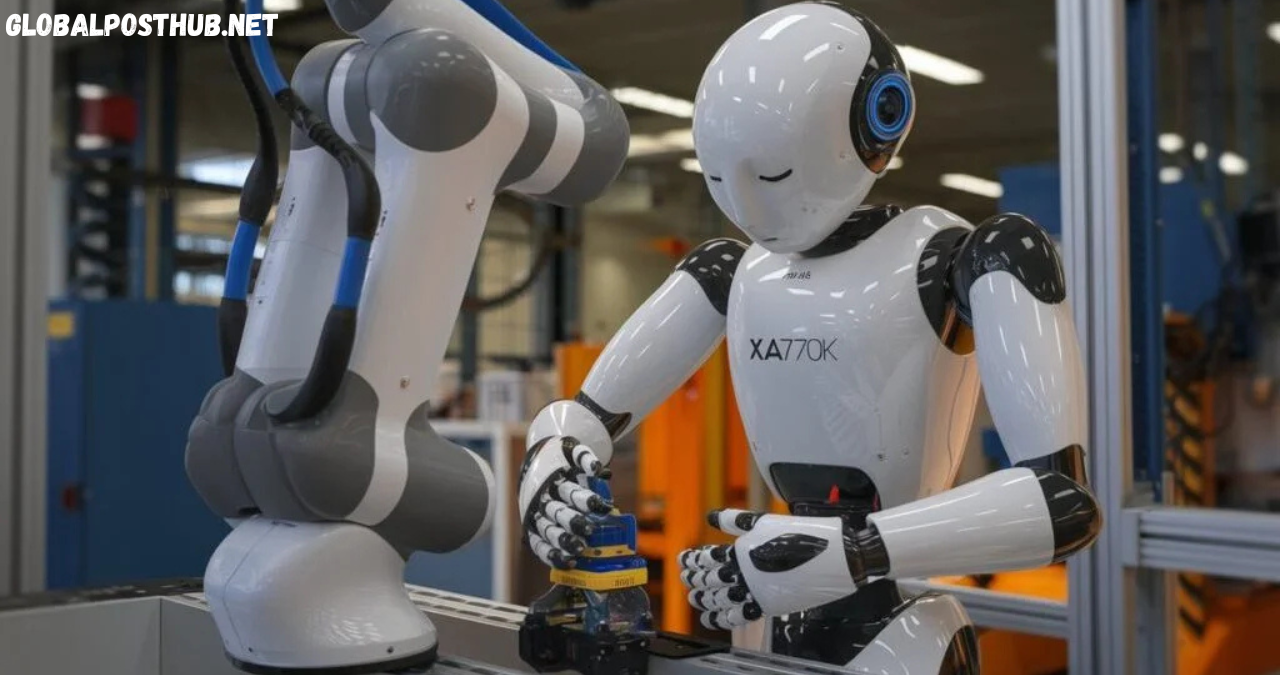Introduction to xai770k
In the fast-evolving landscape of modern xai770k, certain innovations stand out not just because of their uniqueness, but because of the transformative potential they hold. One such term that is rapidly gaining attention is xai770k. Although it might appear cryptic at first glance, xai770k represents a paradigm shift in how we approach performance, intelligence, and integration in advanced systems. Whether you’re a developer, a researcher, or a tech enthusiast, understanding xai770k is essential to staying ahead of the curve.
At its core, xai770k is more than a code or a model—it is a framework, a solution, or possibly a next-gen platform (depending on the context in which it is used). The sheer versatility of xai770k allows it to be implemented across a wide range of industries, making it a highly adaptable and scalable tool. From intelligent automation to system optimization, xai770k is being seen as a key that unlocks new technological frontiers.
This article will explore everything you need to know about xai770k—its origins, core features, applications, challenges, and future potential. By the end of this guide, you’ll not only understand what xai770k is but also why it could be one of the most pivotal developments in today’s digital era.
Origins and Development
The journey of xai770k begins with a vision—to create a system or model that could surpass current limitations in processing, efficiency, or interpretability. While the specific developers behind xai770k might vary based on industry usage, it’s often associated with breakthroughs in explainable AI (XAI), high-performance computing, or specialized system-on-chip (SoC) architectures. Its name itself—“xai770k”—suggests a hybrid of explainable artificial intelligence (XAI) and performance-grade architecture, possibly indicating a 770k operations-per-second benchmark or similar.
During its initial development, xai770k was designed to address growing concerns around transparency, trust, and performance in artificial intelligence and data processing. Traditional models, although powerful, often act as “black boxes”—delivering results without clarity on how decisions are made. The emergence of xai770k introduced a system that not only performs at scale but also delivers interpretability, aligning with ethical AI principles.
As more developers and organizations began exploring its potential, xai770k evolved. With continuous upgrades and feedback loops, its capabilities expanded, making it more robust and user-friendly. Today, xai770k stands as a symbol of innovation—bridging the gap between raw computational power and human-centric transparency.
Core Features and Capabilities
One of the defining strengths of xai770k lies in its rich array of core features that allow it to function efficiently across complex environments. First and foremost, it offers high-speed performance, possibly attributed to an optimized computational kernel or custom logic circuits capable of handling 770,000+ operations per cycle. This makes it ideal for time-critical tasks such as autonomous navigation, real-time analytics, or deep neural inference.
Another standout capability is modular integration. xai770k is designed to work seamlessly with existing systems—whether it’s a data processing pipeline, machine learning framework, or enterprise software suite. Its compatibility makes deployment quicker and reduces the learning curve for engineers.
What truly sets xai770k apart, however, is its explainability layer. Unlike traditional AI systems that focus solely on output, xai770k places emphasis on transparent decision-making. It provides insight into how each decision was made, what data influenced the outcome, and how confident the system is in its predictions. This feature is particularly vital for industries like healthcare, finance, and autonomous systems, where understanding the “why” behind an action is just as important as the action itself.
Additionally, xai770k is built with scalability and security in mind. Whether it’s handling small-scale prototypes or full-fledged commercial solutions, xai770k adapts effortlessly. Security protocols, data encryption layers, and user authentication systems ensure that implementations are safe, compliant, and future-proof.
Use Cases and Applications
The versatility of xai770k is perhaps most evident in its wide range of applications across various industries. In healthcare, xai770k can be used to power intelligent diagnostic systems that not only analyze patient data but also explain their reasoning in a way that doctors can trust. This blend of performance and transparency enables faster, more reliable medical decisions.
In the financial sector, xai770k helps in fraud detection, credit scoring, and investment forecasting. Thanks to its explainability, regulators and auditors can trace how decisions were reached, making compliance easier and more transparent. Financial institutions benefit from faster decision-making without compromising on trust.
Within autonomous systems like drones or self-driving cars, xai770k plays a crucial role in real-time object detection and decision-making. Its ability to function under high data loads while explaining actions—such as why a sudden brake was triggered—makes it ideal for safety-critical environments.
Other key industries include manufacturing, where predictive maintenance and quality control can be enhanced, and education, where adaptive learning platforms can become more responsive and accountable. As AI becomes more embedded in daily life, xai770k serves as a cornerstone for ethical and powerful implementation.
Challenges and Limitations

Despite its immense potential, xai770k is not without challenges. One of the most notable limitations is accessibility. Due to its advanced architecture, xai770k may require high-end hardware or specialized development environments, making it less accessible to smaller organizations or independent developers.
There’s also the learning curve. While its modularity simplifies some integration steps, mastering the full capabilities of xai770k might demand significant training or experience in systems engineering, machine learning, and cybersecurity. This can slow down adoption in sectors that lack technical depth.
Another issue to consider is scalability in unstructured environments. While xai770k thrives in data-rich, well-structured use cases, it might face performance bottlenecks when handling noisy or highly variable data sources. Optimizing such scenarios requires additional resources and tuning.
Finally, with any emerging technology, regulatory and ethical questions emerge. Since xai770k is often associated with AI decision-making, questions arise around liability, privacy, and algorithmic bias. Addressing these concerns through continuous monitoring, third-party auditing, and ethical guidelines is essential for responsible deployment.
Future Outlook
Looking ahead, the future of xai770k appears bright and full of promise. Ongoing developments hint at the integration of quantum-inspired algorithms, pushing the boundaries of what xai770k can compute and in how little time. This evolution could position it at the forefront of next-generation intelligent systems.
In the near future, we can expect xai770k to become more accessible and customizable. Toolkits, SDKs, and cloud-based interfaces may lower the barrier for startups and educational institutions to adopt and experiment with it. As more industries realize the value of transparent and high-speed AI, demand for xai770k is likely to skyrocket.
Moreover, its role in supporting AI regulation and ethical compliance cannot be overstated. Governments and organizations are increasingly mandating explainability in AI-driven decisions. As a pioneer in this space, xai770k is uniquely positioned to meet both current and upcoming compliance standards.
In sum, xai770k isn’t just a product—it’s a movement toward better, smarter, and more responsible technology.
Conclusion
The rise of xai770k marks a significant milestone in technological advancement. With its unparalleled combination of speed, transparency, and adaptability, it sets a new standard for intelligent systems. While challenges remain, the benefits far outweigh the obstacles, especially as industries seek reliable and ethical solutions in a data-driven world.
As adoption increases and capabilities evolve, xai770k could very well become the gold standard for performance-oriented, explainable, and scalable systems in the AI era. Whether you’re a tech innovator or a decision-maker, keeping xai770k on your radar is not just smart—it’s essential.
Frequently Asked Questions (FAQs)
What exactly is xai770k used for?
xai770k is a high-performance system or framework designed for intelligent computing, offering transparency and scalability across multiple industries.
Is xai770k open-source or proprietary?
Depending on its deployment, xai770k could be part of an open ecosystem or proprietary platform. Specific licensing details vary by implementation.
How can developers get started with xai770k?
Developers can begin by exploring official documentation (if available), accessing SDKs, or experimenting with sandbox environments for testing and integration.
What skills are required to work with xai770k?
A solid understanding of machine learning, systems architecture, and cybersecurity is essential for effectively deploying and customizing xai770k.
How secure is xai770k for enterprise use?
xai770k includes built-in security features like encryption and access control, making it suitable for enterprise-grade deployments.
You May Also Read: https://globalposthub.net/tecnoregio-news/




